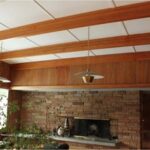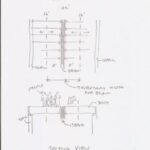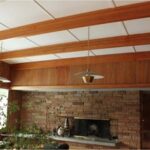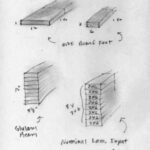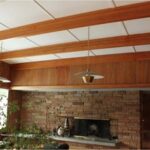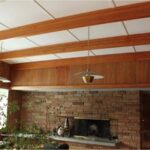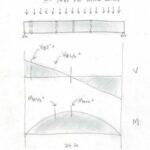This article contains the steps and Design Checks for designing (specifying) a typical Glued Laminated Timber (Glulam) Beam. Glulam beams are often specified by Engineers and by Architects. Subject to the approval of the Building Official, they may also be designed by Owners and Contractors. In reality, Glulam beams are not uncommonly designed by just about anyone with interest in a building project, including Distributors, and even `the guy behind the counter’ at the local building supply store. My purpose in this article is not to say who should and who shouldn’t design a Glulam beam; instead, I want whoever ends up doing it to know what they are doing. From a professional standpoint beams should be designed by licensed Professional Architects and Engineers (and from a personal standpoint I want that Professional to be me). From an educational standpoint that designer is you, the reader, regardless of your education, experience, or role in the design and construction process. My wish with this article is that you learn; and if you get stuck, obtain the assistance of a qualified professional.
Here goes:
1. Determine the intended in-place, in-service conditions of the beam.
Service conditions include:
1) Span
2) Preferred or Available Depth
3) Preferred or Available Width
4) Visibility Condition
5) Required Service Conditions with Respect Occupants and Materials
6) Available Bracing
Good design practice goes beyond specifying a member that is simply `strong enough’. Specification of a Glulam beam (or any beam) should take into consideration of how it `fits’ into the rest of the structure. Beam sizes should be selected that `fit’ well into the rest of the framing. A beam Appearance Grade should be selected that is appropriate to the framing conditions and wishes of the Owner. In addition to being strong enough, a beam should be `stiff’ enough for its intended service. Minimum stiffness required by Building Codes may satisfy a Building Official but may not satisfy the Owner. As designers we sometimes have to guide the Owner in providing for us his or her `serviceability’ requirements. Serviceability issues include the avoidance of cracking of supported materials, avoidance of `bounce’, and the avoidance of `visible’ sag. Cracking and bounce may be avoided by increased stiffness of a beam; visible sag can be mitigated by specifying camber.
2. Determine the design loads the structure may be subject to.
Our responsibility as designers is to determine (or obtain) the loads thaT the beam may be reasonably subject to for the life of the structure. These loads commonly include (for a Glulam Beam):
1) Occupancy `Live’ Loads
2) Roof Loads (Roof `Live’ or Snow)
3) Dead Loads (Building Weights)
And sometimes include
4) Wind Loads
And
5) Earthquake Loads.
Occupancy Live loads are generally dictated by building codes. Common examples include `area’ loads such as 40 pounds per square foot (psf) `Live’ load for Residential Construction (people, furniture, etc.), 50 psf for `Office’ (Live) load, 100 psf for `Assembly’ areas, and so on. Though often treated as maximum values they are indeed minimum values. As designers we must be enough conscious of anticipated in-service conditions of the structure and `our beam’ to prescribe greater or additional loads as needed. In this regard it is important to know as much about the structure and site as possible, and this is often best accomplished by `site visit’. Site visits often disclose information otherwise unknown. Examples of such include discovering conditions producing higher than Code-dictated wind speeds, and conditions producing excessive snow drifting.
Dead loads are generally the weights of the building materials. They may be calculated directly based on planned construction materials, or estimated, or presumed. Example direct calculations of Dead loads are the subject of another article. Based on experience and general knowledge of building construction the designer may `estimate’ dead loads. For example, typical wood framing for Residential construction around here `weights about 12 psf’ (unless the roof is really steep). Sometimes `presumed’ Dead loads are used, particularly with preliminary designs and investigations. In a preliminary design, for example, a wood frame floor may be presumed to weigh 10 psf.
All that said, as designers, `at the end of the day’, we need to make sure all calculations, estimations, assumptions, and presumptions, are indeed suitable for the design in question. The assumption of a lightly loaded garage floor is not appropriate if we discover that the Owner also intends to use the garage for heavy storage.
3. Determine the Applied Loads to the Beam.
Once the loads for the structure are determined, or at least the loads relevant to the beam being designed, the loads as they directly load the beam may be determined. Common equations used to determine the loads applied directly to the beam include:
w = σ x S … or … w = σ x s,
where
w is a `line’ load (pounds per foot, or plf),
σ is an `area’ load, typically in psf,
S is the tributary width (width of floor, roof, or other area `contributing’ load to the beam), and
s is spacing.
Tributary width and spacing are often interchangeable in that the width of floor (or roof) contributing to a single beam is essentially the spacing of multiple such beams (each beam `carrying’ half the width or spacing to adjacent beams on each side).
P = σ x A,
where
P is a concentrated load, for example, as arriving on a beam from a column or post, and
A is the `Area’ of floor contributing load to the column or post.
w = γ x A,
where in this case w is the weight of the beam itself, in plf, also denoted ws.w.,
γ is the specific weight of the beam (pounds per cubic foot, or pcf), and
A is the cross section area of the beam.
4. Determine suitable Species and Grades of Beams Available.
The Glued Laminated Timber Industry publishes a whole host of acceptable beam `layups’. It is incumbent on the designer to determine which layups or Combination Symbols or Stress Classes are available or suitable for the beam in question. Often this is a regional issue. Specifying the most readily available Combination or Stress Class generally results in the best economy and should not delay delivery. In my region the typically available Glulam beam is the 24F-V4 Douglas fir (DF) beam. This beam falls in the 24F-1.8E Stress Class, if I wish to specify it by class. The 24F-V8 DF beam is also available. Unbalanced (V4) beams should be specified for simple span beams. Balanced (reversible, V8) should be specified for continuous beams, beams with significant cantilevers or overhands, or others with significant negative bending moments.
5. Determine Beam (Beam Size).
Generally the beam size is determined (designed) by investigating the following:
1) Bending
2) Shear
3) Deflection
The Bending and Shear Design Checks are generally of the form:
(Is) … fb ≤ Fb‘?
and
(Is) … fv ≤ Fv‘?
where
f (lower case) is the stress in the material under design load, and
F’ (upper case and `prime’) is the Allowable Stress obtained by multiplying the appropriate Design Value by the appropriate Adjustment factors.
Structural Glued Laminated Timbers are manufactured in rectangular shapes. As such,
fv = 3 V / 2 A,
and
fb = M / S
where
V is the design shear force on the beam,
A is the cross section area of the beam,
M is the design bending moment, and
S is the section modulus for the beam,
S = bh2/6.
The deflection Design Check may follow the form,
(Is) … Δ ≤ Δ allowable,
where
Δ is the deflection under load, generally in the form of,
Δ = K W (or P) L3 / E I,
where
K is a coefficient based on the distribution of load and support conditions,
W is the `Whole’ load on the beam,
L is the span,
E is the Modulus of Elasticity (Apparent Modulus of Elasticity, including the effect of Shear Deflection), and
I is the Moment of Inertia,
I = bh3/12 for rectangular sections.
Allowable deflections are generally in terms of some fraction of the beam span (L/360, L/240, etc.) but may also be prescribed amounts (1/2 in., etc.).
A great majority of beams are used as simple beams (supported at ends) carrying uniform loads, such that
(Uniform Load)
W = w x L,
(Uniform Load, Simple Beam)
V = W / 2,
M = W L / 8,
and
K = (5/384), or
Δ = 5 W L3 / 384 E I.
The NDS provides for the omission of uniform loads acting within distance d from the end of a beam when such loads are applied to the top of the beam and the beam is supported from below (where d is the beam depth). Sometimes this is denoted `V @ d’. Only if it is anticipated or determined that shear controls the design of a beam does this designer utilize that provision. (It’s easier to simply use V = W/2 or V = R where R is the beam reaction.)
Note that while Glulam beams are fairly complicated with regard to layup and manufacturing, from a design standpoint the equations are relatively simple.
Determining an appropriate size beam based on Bending, Shear, and Deflection may follow any number of paths, examples of which are listed below.
1) `Try’ a particular beam size, and check that the size satisfies the Bending, Shear, and Deflection Design Checks. If it does not, typically a larger size is required. If it does, then the beam is satisfactory. If is satisfies the design checks `by a long ways’ (large amounts of excess capacity), then it might be prudent to try a smaller size.
2) Determine minimum section properties A, S, and I from the above equations by setting the applied stress equal to the Allowable stress (and calculated deflection equal to the Allowable deflection) and then select a member size that has section properties equaling or those determined.
Let fv = 3 V / 2 A = Fv‘ and solve for A (A needed),
(let) fb = M/S = Fb‘ and solve for S (S needed), and
(let) Δ = Δ allowable and solve for I (I needed).
3) Generally the design of short span beams is controlled by the shear Design Check, `medium-span’ and continuous span beams by bending, and long span beams by deflection. Another approach to beam design is to assume a certain condition controls, for example bending, determine a required beam size by setting the design stress equal to the Allowable stress for that condition, calculating a needed section property, in this case Section Modulus, S. Once a beam size has been selected, the other design conditions are checked, for example shear and deflection.
6. Determine Minimum Bearing Length.
Once a suitable beam size is determined for a particular application a minimum bearing length is typically specified. This is the equivalent of the Bearing Stress Design Check, and is accomplished by setting the applied bearing stress (Compression Perpendicular to Grain at the support conditions) equal to the Allowable bearing stress (Allowable Compression Perpendicular to Grain). In equation form,
Let fc perp = R / A bearing = R / (b x lb) = Fc perp‘, or
lb (min.) = R / (b x Fc perp‘),
where
R is the Reaction force under consideration,
b is the beam width (assuming it bears over its full width), and
lb is the length of bearing (beam contact with support).
7. Specify Bracing
In general Glulam beams must be supported at their ends to prevent rotation. Generally this is accomplished by `Accepted’ or `Good’ framing practice using straps, end or slant or toe-nailing, blocking, or approved connection hardware. Bracing of the compression zone of a glulam is often accomplished by attachment to the system it is supporting, such as a roof or floor. If additional bracing is required it should be so specified. If necessary the nailing or strapping described above should be shown on the Construction Documents. Beam bracing is covered in greater detail in other articles.
8. Determine Anchorage
All beams must be anchored in place, even where designed to resist only gravity or `downward’ loads. Anchorage is often provided by the use of Approved connection hardware or `Good Framing Practice’. Where anchorage must be calculated it can be considered to be some fraction of the design Live and Dead loads for the beam, acting along the axis of the beam.
9. Specify camber
Unbalanced beams are generally manufactured with standard camber amounts. Where deflections are of particular concern for a beam, particularly Dead load deflections, specific camber amounts may be calculated and specified. In this regard the particular beam becomes a `custom’ beam. Custom cambers may require additional delivery time. Where camber is required it may be beneficial to first investigate the suitability of the camber of more readily available stock beams. Typical camber amounts, where calculated, are taken to be 1.5 times the immediate Dead load deflection for the beam.
10. Specify Appearance Grade
Appearance Grade for the beam should be specified based on visibility of the beam and Owner requirements. Appearance Grades vary from `Framing’ to `Premium’. Framing Grade is intended for members that will be covered by other materials (not visible). Generally the higher the Appearance Grade the higher the cost, but cost may also be determined by availability. Custom appearances are also available.
Design examples for several specific beams following the steps above are provided in following articles.
References
National Design Specification for Wood Construction (NDS) and Supplement – Design Values for Wood Construction, 2005 (and 2012), American Forest and Paper Association, Washington, D.C.
Standard Specification for Structural Glued Laminated Timber, AITC 117, 2004 (and 2010), American Institute of Timber Construction, Centennial, CO.
Timber Construction Manual, Sixth Edition, American Institute of Timber Construction, Centennial, CO, John Wiley & Sons, Hoboken, NJ.
